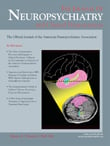SIR: Huntington’s disease causes chorea and psychiatric abnormalities. Psychiatric symptoms were found in one study in 51 out of 52 patients.
1 Dysphoria, agitation, irritability, apathy, and anxiety were found in above 50% of the patients sampled.
Many sources postulate that cannabinoids could have a beneficial effect on the symptoms of Huntington’s disease, especially on choreatic movements.
2 –
4 As well as providing possible symptomatic relief in Huntington’s disease, there is also some evidence
5 that cannabinoids might have a neuroprotective effect which could delay the onset of symptoms by delaying or preventing the death of striatal neurons. This neuroprotective effect has also been postulated by other sources.
6 –
8To date there are only two reports on the use of cannabinoids in Huntington’s disease in the literature. Cannabidiol, a nonpsychotropic cannabinoid, had no effect on chorea severity in 15 patients.
9 In one single patient, single dose, uncontrolled open clinical trial using nabilone, 1.5mg, the chorea increased significantly.
10 We present a case of a female patient with irritability, which improved after the introduction of cannabis. This improvement was maintained by treatment with nabilone.
Case Report
The patient was a 43-year-old female who died in December 2003. She developed symptoms of Huntington’s disease at the age of 24 and her husband gave up paid employment to care for her in 1990 when she was 30 years old. In 1995, he reported difficulties in caring for his wife. These difficulties were related to personality changes due to her illness. She increasingly resisted help from professionals, especially care assistants, and refused any suggestion of short-term respite care. She became disinhibited and frequently undressed herself and walked around naked inside and occasionally outside the house. She exhibited a number of dangerous behaviors, such as leaving taps running and fires burning, and leaving burning cigarettes around. Her husband became concerned about the effect that the care for his chronically ill wife was having on his son, who was born in 1984.
The patient went into residential care in 1996. The patient’s husband visited two or three times every week and he always took his wife out for a trip. These trips were difficult because of the patient’s refusal to be strapped into the car or her wheelchair, which sometimes resulted in falls caused by violent choreic movements when he was unable to physically hold her in the chair because he was using his hands for some other purpose.
In 2001, he began to give his wife cannabis to smoke when he took her out on these regular trips. When he returned his wife to the nursing home after these visits the staff were aware of a significant difference in the patient. The cannabis appeared to improve her mood and she was calmer and more relaxed. Prior to the introduction of cannabis she was extremely impatient and would get angry if required to wait even a few minutes for a cigarette. After taking cannabis, she was able to wait a while without screaming and throwing things. The patient also willingly accepted the use of a car seat belt and wheelchair harness.
In December 2001, the local general practitioner prescribed a regimen of nabilone, a synthetic 9-keto cannabinoid, which the patient began taking, 1mg each day. The husband and the nursing home staff both reported improvements in behavior and reduction of chorea coinciding with the introduction of cannabis and maintained by daily taking nabilone.
Comment
This report has many limitations. It is a single case report and no measurements were taken at the time of the introduction of cannabis and nabilone. The information was obtained by interviewing the husband and staff from the care home in 2005. The symptoms of Huntington’s disease do change over time and the movements are different in the later stages of the disease. However both the husband and the staff are sure that the introduction of cannabis was beneficial and greatly improved the patient’s quality of life in her last years. There is need for further trials to establish the therapeutic use of cannabinoids in the symptomatic treatment of Huntington’s disease.
Acknowledgments
The first author receives an unrestricted educational grant from Cambridge Laboratories, which holds the European marketing rights for nabilone.

